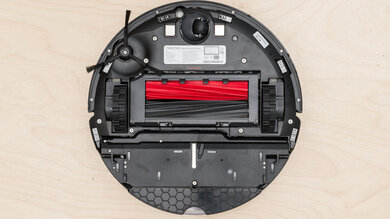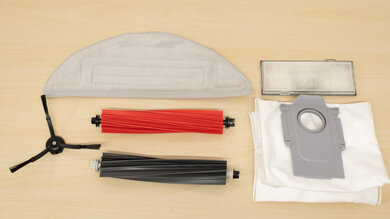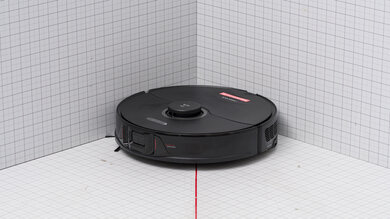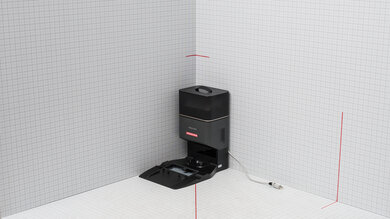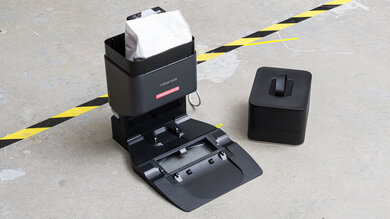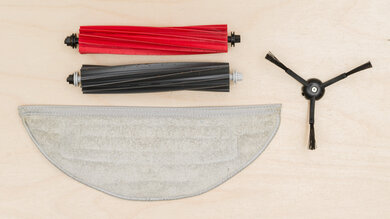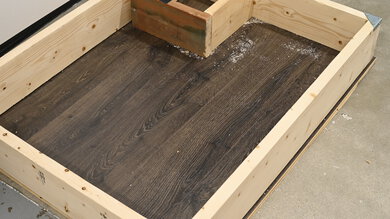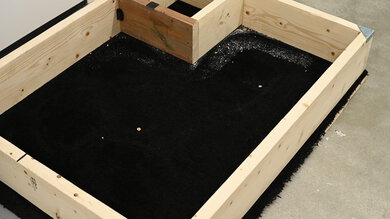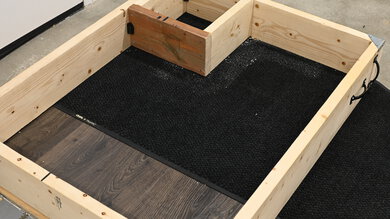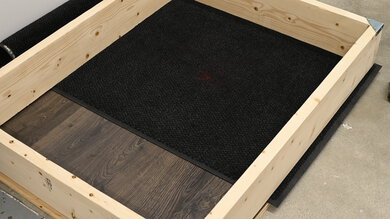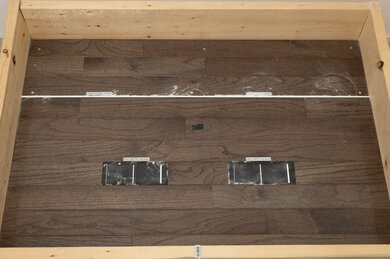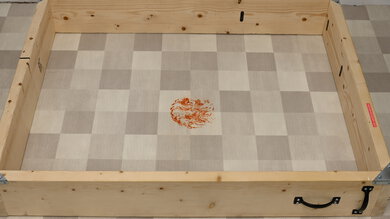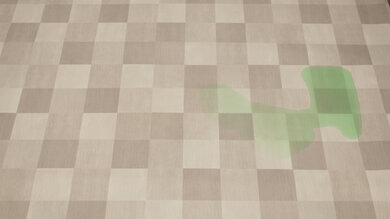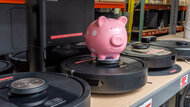The Roborock S8 sits near the top of Roborock's extensive lineup of robot vacuums, just below the mechanically similar Roborock S8 Pro Ultra, which has a few minor improvements. It's a minor upgrade over the existing Roborock S7 MaxV, with the same dual-sensor mapping and hazard recognition system, a slightly more powerful suction motor, and a new cleaning head with twin rubber rollers that are more resistant to hair wraps.
Our Verdict
The Roborock S8 is a decent choice for a multi-surface household. Its performance on hard floors is good, although it's a little worse on carpet—it's still satisfactory but leaves more fine material along edges and in corners. Its twin brushrolls do a great job with pet hair on carpet. Its obstacle handling is okay, though its obstacle avoidance system works better on bare floor than on carpet. The S8's basic dock only provides charging capability. However, the self-emptying station with the S8+ is passable; it empties the dustbin but isn't equipped to help with the mopping function. The robot vacuum's mopping ability is alright; it works reasonably well on stains.
-
Good performance on bare floors.
-
Fairly effective mopping system.
-
Good obstacle recognition and avoidance on bare floors.
-
Effective at picking up debris and pet hair on carpet.
-
Struggles a little with debris in corners on bare floors.
-
Poor obstacle recognition and avoidance on high-pile carpet.
-
Leaves fine debris on carpet edges and corners.
The Roborock S8 does a decent job of handling pet hair on floors. Its cleaning head uses twin rubber rollers, which are easy to clean and don't get tangled easily. Its mopping system does a great job of scrubbing away any dirt or mud that your pet might track in from the outdoors. Its hazard recognition system allows it to automatically avoid hazards like pet waste. However, it does a terrible job of sealing in most common allergens, like pet dander.
-
Relatively easy to maintain.
-
Poor air filtration performance.
The Roborock S8 has good hard floor pick-up. It vacuums up all debris types pretty well and covers the floor area thoroughly. It does miss finer debris on wall edges and in corners, though.
-
Good performance on bare floors.
The Roborock S8 has decent performance on carpets. It's fairly effective with material that passes under the center of the vacuum, but it can't pick up fine material that's off to the sides. The vacuum's side brush can't move it since it's embedded in the carpet, so it gets left behind. This means it leaves fine material along wall edges and in corners.
-
Effective at picking up debris and pet hair on carpet.
-
Leaves fine debris on carpet edges and corners.
The Roborock S8 does a great job picking up pet hair from carpets. The twin rubber brushrolls are quite effective at lifting up pet hair. Its efficient pathing and navigation makes it pass over pet hair deposits thoroughly, allowing the brushrolls to do their work and leaving only a little embedded hair behind.
-
Effective at picking up debris and pet hair on carpet.
The Roborock S8 is alright at handling obstacles. It does quite well on bare floors, where it recognizes and avoids almost everything. It gives even thin objects like coat racks just enough clearance to vacuum around them without touching them. It doesn't fare as well on carpeted floors, where its obstacle recognition and avoidance become fairly poor. It also may suck up loose tasseled rugs since it doesn't recognize the tassels as obstacles and can get itself tangled up in them.
-
Good obstacle recognition and avoidance on bare floors.
-
Poor obstacle recognition and avoidance on high-pile carpet.
- 7.2 Multi-Surface Household
- 7.1 Pets
Performance Usages
- 7.5 Debris Pickup: Hard Floor
- 7.2 Debris Pickup: Carpet
- 8.0 Debris Pickup: Pet Hair
- 6.5 Obstacle Handling
Changelog
-
Updated Jul 17, 2025:
We added new types of obstacle avoidance technology to the Obstacle Avoidance test box.
-
Updated Apr 16, 2025:
We've added text to this review for the new tests added in Test Bench 1.0.
- Updated Apr 16, 2025: We've converted this review to Test Bench 1.0, which updates our performance testing to include new tests to evaluate Obstacle Adaptability, Obstacle Avoidance, Height Clearance, and Threshold Clearance. We've also introduced new performance usages. For more information, see our changelog.
-
Updated Jan 29, 2025:
Added the Dreame L40 Ultra as a more feature-rich alternative in the Quality of Life Features section.
-
Updated Jan 06, 2025:
We've added the Roborock Qrevo Curv as an alternative with better hard floor cleaning performance in the Hard Floor Pick-Up section.
Check Price
Differences Between Sizes And Variants
There are two variants of the Roborock S8: the basic variant, referred to as the S8, and the S8+, which comes bundled with Roborock's Auto-Empty Dock Pure station. Both models can be purchased in either white or black. We tested the S8+ variant in black; see its label. Both vacuums are mechanically identical and deliver similar overall cleaning performance, though the inclusion of the auto-empty dock in the S8+ reduces hands-on maintenance requirements.
The Roborock S8 Pro Ultra is mechanically similar to the S8/S8+ but is still treated as a distinct model. Not only does it come with a more advanced docking station that empties its dustbin, refills its water tank, and washes and dries its mopping pad, but it also has a wider mopping module.
If someone comes across a differently equipped variant of this vacuum, let us know in the comments, and we'll update our review.
Compared To Other Robot Vacuums
The Roborock S8 is an upper mid-range robot vacuum that offers a wide range of convenience features and a strong overall performance on a wide variety of surface types, comfortably exceeding the majority of other models on the market. It's not necessarily a revolutionary upgrade over the older Roborock S7 MaxV. However, it still improves upon its predecessor in a few small but welcome ways, with an easier-to-clean dual-roller cleaning head and a slightly more potent suction motor.
The S8+ is priced similarly to the Dreame L10s Ultra, and although Dreame's dock adds mop washing and tank refilling capabilities, the Roborock S8+ performs better.
If you're looking for alternatives, look at our list of recommendations for the best robot vacuums, the best robot vacuums for hardwood floors, and the best robot vacuums for carpet.
The Roborock S8 is better than the Roborock S7. The S8 has a more powerful suction motor and a more effective twin roll cleaning head, resulting in much better pet hair pick-up. The S8 also features a separate front-facing optical sensor that allows it to spot, identify, and react to obstacles placed in its way. That said, the S7 uses the same mopping feature and is still a good way of getting a well-rounded robot vacuum for a more affordable price.
The Roborock Qrevo S packs in a few more features than the Roborock S8+/S8. The Qrevo S has a multifunction dock that not only empties out the vacuum's dustbin but also refills its internal water tank and washes and dries its mopping pads. The Qrevo S also has a more effective mopping system. On the other hand, the S8+ feels like the more premium vacuum, with more robust build quality. Its twin roller cleaning head also does a better job of dealing with pet hair.
The Roborock S8 is better than the Roborock Q5, but that isn't surprising, given the significant price disparity. The S8 features a front-facing optical sensor that allows it to react to hazards in real-time, a dual-roller cleaning head that does a better job of resisting hair wraps, and a highly effective mopping system. That said, the Q5's standard-fit bristled roller does provide more surface agitation on carpet, which helps offset a portion of its on-paper power deficit.
The Roborock S8 is a slight upgrade over the Roborock S7 MaxV, though the vacuums are still pretty similar overall. The S8 has a slightly more potent suction motor and a new dual-roller floorhead, resulting in slightly better debris pickup on most floor types and improving its ability to clear away pet hair. The S8 is also noticeably quieter. The S7 MaxV has a color-capable camera and a built-in microphone, so you can use it as a roving security camera. Unlike the standard S8, it's also available with a docking station that empties its dustbin, washes its mop pad, and refills its water tank.
The Roborock S8+/S8 is a bit better than the Roborock Qrevo, though the latter is still a great option if you aren't willing to spend as much. The S8 feels a little better built, has fewer parts that need to be cleaned periodically, and has a slightly more sophisticated real-time hazard avoidance system. It also delivers better overall debris-pickup performance, and its twin-roller head is more resistant to hair wraps. That said, the Qrevo's multifunction dock offers far more functionality than the dock included with the S8+ variant; not only does it empty the vacuum's internal dustbin, it also refills its water tank for mopping and washes and dries its mop pads.
The Roborock S8 Pro Ultra is a better vacuum than the Roborock S8+/S8. The S8 Pro Ultra has a more advanced multifunction dock that empties its dustbin, washes and dries its mop pad, and refills its water tank. The S8 Pro Ultra also has a lifting brush head that can keep the brushes from being stained as it mops. The Pro Ultra has a fast-charging feature, too, leading to less downtime between cleaning sessions. However, it's worth noting that the regular S8's VibraRise mopping system is a little better at dealing with stains compared to the S8 Pro Ultra's VibraRise 2.0 system.
The Dreame L10s Ultra is a more feature-packed vacuum than the Roborock S8+/S8, but the latter is simply a stronger overall performer. The Dreame is bundled with a more advanced multifunction dock that not only empties its dustbin but also refills its water tank and cleans and dries its mopping pads; you'll need to upgrade to the more expensive Roborock S8 Pro Ultra to get these features. The Dreame vacuum also has a more advanced hazard avoidance system than the regular S8, with the addition of a color-capable camera. That said, the Roborock clears away more debris on carpeted floors, and its twin roller head is far more effective in cleaning pet hair. Its mopping system is also far more effective; the Roborock vacuum's scrubbing does a better job of dealing with stains with just water compared to the Dreame's system, which performs best with the addition of detergent.
The Roborock Qrevo Curv and the Roborock S8+/S8 are two of Roborock's premium robot vacuum offerings. The Curv is newer, performs better, and offers innovations over the older model. Of note is the Curv's FlexiArm system. This allows its side brush and mop cloth to extend beyond the vacuum's chassis and overcome the poor corner cleaning performance that plagues most circular robot vacuums. There's also the AdaptiLift system, which can individually lift the wheels to maneuver over thresholds and obstacles up to 4 cm (1.6") tall; it can work very well but delivers inconsistent results depending on the surface type. Despite the Curv having a more advanced RGB camera system, this doesn't result in massively improved hazard avoidance, with both vacuums being liable to bump into things like loose socks or power cords left on the ground.
As the flagship model in the Roborock lineup, the Roborock S8 is better than the Roborock Q7 Max. The S8 has a more powerful suction motor and a twin roller floorhead, improving debris pickup across most surface types. Its front-facing camera system allows it to spot and react to hazards in real-time. The S8 also feels better built and has a vibrating mop system that's more efficient in scrubbing away stains.
The Roborock S8 is better than the iRobot Roomba j7. Both vacuums offer hazard avoidance capability, enabling them to spot and react to obstacles placed in their way in real-time. While the Roborock features an additional LIDAR sensor, resulting in faster room mapping and much-improved low-light maneuverability, the iRobot's camera-based hazard identification system is far better at spotting and reacting to obstacles. The Roborock has a more potent suction motor, resulting in better debris pickup across different surfaces, and has a mopping feature that is very effective in dealing with stains.
The Roborock S8+/S8 is better than the iRobot Roomba j9+. The Roborock features a LIDAR mapping sensor that allows for quicker and more precise room mapping, and it boasts a lot more automation features, not to mention a more feature-rich and less buggy companion app. The Roborock generates a live map of its coverage area, allows you to change power settings on the fly, and supports pin-and-go functionality. Both vacuums feature real-time hazard identification systems, and though the iRobot's RGB camera-based system does a better job of navigating around obstacles. Meanwhile, the Roborock also features an ultrasonic mopping system that effectively handles dried-on stains. If you want the same capability in the iRobot, you'll need to step up to the pricier iRobot Roomba j9+ Combo model.
The Roborock S8+/S8 is a stronger performer than the eufy X10 Pro Omni, though you'll have to pay a hefty premium to get an S8 model that offers the same range of features. Unlike the eufy, the standard S8's docking station only empties its base station, whereas the eufy's also washes and dries its mop pads and refills its water tank. You'll need to upgrade to the Roborock S8 Pro Ultra to get that capability in the Roborock. The eufy's more advanced obstacle avoidance system is only marginally more effective than the Roborock's, though. As well, the Roborock's mopping system does a better job of scrubbing away stains.
The Roborock S8+/S8 is better than the Roborock Q5 Max+, but the latter is still a good value-conscious option if you don't need all the features found on the former. The S8 can pull double duty as a robot mop, and it features the manufacturer's ReactiveAI obstacle avoidance system, so you don't have to make sure your home is completely free of obstacles before letting it run a cleaning job. On the other hand, the Q5 Max+'s lack of a mopping system means it doesn't need a water tank, resulting in less overall upkeep and a higher-capacity dustbin.
The Roborock S8+/S8 and the Roborock Qrevo Pro suit slightly different uses. The Qrevo Pro provides a somewhat more hands-off ownership experience thanks to its multifunction dock, which empties the vacuum's internal dustbin and refills its water tank for mopping and washes and dries its mop pads. Its twin-pad mopping system also provides superior overall stain-clearing performance. Meanwhile, the S8 does a better job of maneuvering itself and is more effective in clearing away debris on carpets. Its twin roller head also makes it the better option for pet owners: this design is more resistant to hair wraps and better at dealing with hair in general.
The Dreame L40 Ultra is much more feature-rich than the Roborock S8+/S8, but the Roborock has the edge performance-wise. The L40 Ultra's base station can empty its dustbin, refill its water tank, and clean and dry its mopping pads with hot water and air. The obstacle avoidance system is also much more advanced than the S8, with an RGB camera, LED light, and a more advanced sensor. That said, the Roborock is more effective on every surface type and offers better mopping performance. These performance differences are mostly due to the L40 Ultra's haphazard pathing, which yields inconsistent results.
The Roborock S8+/S8 performs better than the Shark PowerDetect RV2820ZE on almost every floor surface. The upgraded Shark dock has more capabilities than Roborock's dock, yet performance is still lacking in comparison to the Roborock vacuum. As well, the Roborock is much easier to maintain, and Roborock's control app is excellent, much better than the very basic SharkClean app.
The Roborock S8+ is a better robot vacuum than the eufy E20. The Roborock performs much better on carpet and in picking up pet hair. The S8+ variant comes with a self-emptying docking station like the eufy E20, but at a higher cost than the eufy. The Roborock S8/S8+ has mopping ability, which the eufy lacks. However, the eufy E20 is a little better on bare floors, and its obstacle avoidance is much better than the Roborock S8.
As far as hybrid robot vacuums/mops go, the Roborock S8+/S8 is better than the Shark IQ 2-in-1, though that isn't too surprising given the significant gulf in price between the two. The Roborock feels better built, does a better job of maneuvering itself, has an even more feature-rich yet intuitive app, and has a real-time hazard avoidance system. Better yet, it's fully compatible with a base station that empties its dustbin, refills its water tank, and washes and dries its mop pad.
The Roborock S8 is better than the iRobot Roomba S9. The S8 has both LIDAR and front-facing optical sensors, allowing for quick and precise room mapping, even in the dark, and real-time hazard avoidance capability. The S8 is also equipped with an impressive mopping system that deals with stains on hard floors. Both vacuums have cleaning heads with twin rubber rollers that do a fantastic job of handling pet hair and are easy to clean. That said, the iRobot does a much better job of sealing in allergens like pet dander. It also clears away more debris on most floor surfaces.
The mid-range Roborock S8+/S8 is a better robot vacuum for most usages versus the much more expensive Dyson 360 Vis Nav. The S8+/S8 performs better on all floor types and adds mopping. The basic charging-only dock included with the S8 matches the Dyson's dock, but the self-emptying dock included with the S8+ is more convenient than the Dyson's. The Roborock's suction and airflow come nowhere near the leading Dyson, yet the Roborock S8+/S8 makes up for this deficiency with better pathing and navigation to achieve better performance.
Test Results
This vacuum feels very well-built. It's very similar in feel to the older Roborock S7 MaxV, with a body made mostly from high-grade plastic with a matte finish. You can lift the top cover to see the Wi-Fi indicator light and system reset button. Like its predecessor, it has a front-facing camera to scan for hazards, but unlike that model, you can't look through it. You'll notice the biggest difference from the S7 MaxV on its underside: the S8 uses a new cleaning head with twin rubber rollers, similar to iRobot models like the iRobot Roomba S9. It has a single side brush to direct debris into the path of its cleaning head but with three arms instead of five.
The out-of-the-box setup isn't too difficult. You must download the Roborock companion app to complete the setup process and pair the vacuum with its docking station.
The Roborock S8 is fairly easy to maintain. You can keep tabs on the maintenance intervals of different components through the 'Help' menu in the vacuum's companion app.
- Dirt compartment: The internal dustbin can be removed by pressing the release tabs on either end of the dirt compartment. You can empty it over a trash bin, but if you buy the S8+ variant, it will automatically transfer debris from its dustbin into the dirtbag inside the charging dock. If necessary, wash it with water, but remove the filter beforehand. The dirt compartment must dry for 24 hours before it's put back in the vacuum.
- Base station dirtbag: The S8+ variant comes with a base station that contains a dirtbag, which can simply be pulled out of its housing after you remove the top cover. A cover on the dirtbag automatically seals the bag after removal, preventing dust and debris from spilling out. It isn't reusable and must be thrown away when it's full. It has an advertised capacity of seven weeks' worth of debris, though you'll likely find it less than that depending on whether or not you have floors that gather a lot of dirt, dust, and pet hair. You can use the small screwdriver packaged with the base station to remove debris clogging the inlet to the dirtbag.
- E11 filter: The filter is located inside the dirt compartment and can be unclipped from its housing pretty easily. It has a simple design and isn't especially difficult to clean. You should wash it every two weeks.
- Brushrolls: The twin rubber brushrolls can be accessed by lifting the brush guard on the bottom of the vacuum and pulling them out. Compared to older Roborock models, which featured only a single roller, the S8 has twin rubber rollers with removable bearings, making it a cinch to clear away the small amounts of pet hair that can get stuck. You should clean them by removing any tangled hair or stuck-on debris once or twice a week, depending on whether or not you have any pets.
- Side brush: Unfortunately, you'll need a screwdriver to remove the retaining screw holding the side brush in place, so it isn't quite as easy to clean as most of the other components on this vacuum. You should clear away any stuck-on debris once a month.
- Omni-directional wheel: The omnidirectional front wheel takes quite a bit of effort to pull free of its socket, and you'll probably need to use a pair of pliers for extra leverage. You should clear it of any tangled hair or debris every month.
- Mop cloth: The mopping cloth can be removed from its mounting plate and slid out. You should clean it under water after each use.
- Water tank: You can pull the water tank out from the back of the vacuum. You can clean it as required by filling it with clean water, shaking it gently, and then pouring out the dirty water.
Any component washed under water should dry for at least 24 hours before being reinserted in the vacuum.
This vacuum incurs high recurring costs.
- Brushrolls: The brushrolls need replacing after 300 hours of use or every six to 12 months. Replacements can be purchased on the company's website.
- Side brush: The side brush has a service life of 200 hours or approximately three to six months of use. You can buy a two-pack of replacements from Roborock's website.
- Filter: The filter needs replacing following 150 hours of usage, according to the maintenance tab of the companion app. You can buy replacements in packs of two from Roborock.
- Mop cloth: You should replace the mop cloth every three to six months. Replacements can be bought in packs of two from the company's website.
The S8+ version of the Roborock S8 is very easy to store. The vacuum itself isn't that big, and its self-emptying rack station has the same dimensions as the Roborock Q5+, which makes it pretty easy to fit between nooks in furniture. It also has a built-in rack to store any excess power cord length. Still, if you don't have a lot of space at home, you might be better off going for the basic S8 variant, which doesn't come with the self-emptying station.
This vacuum has a small internal dirt compartment. As a result, in the case of the standard Roborock S8, you'll need to empty it manually at the end of practically every cleaning session, while in the case of the S8+, it'll need to return to its dock to self-empty often. The dustbin doesn't have a fill sensor; instead, you'll receive reminders through the app recommending that you empty the bin regularly. If you want a robot vacuum with a bigger internal dustbin, the Roborock Q5 Max+ is worth a look.
The Roborock S8+ variant of this vacuum comes with a self-emptying base station, which transfers debris from the vacuum's dustbin into a 2.5L dirtbag. This is a comparatively simple docking station, with no mop washing or water refilling capabilities to be found. If you want a robot vacuum with a multifunction dock, the Dreame L10s Ultra is a good option.
- Roborock S8 vacuum
- Dirt compartment
- Auto-Empty Dock Pure self-emptying charging station (only included with S8+ model)
- Auto-Empty Dock Pure self-emptying charging station top cover (only included with S8+ model)
- Auto-Empty Dock Pure self-emptying charging station power cable (only included with S8+ model)
- 2x dirtbags (only included with S8+ model)
- Charging station (only included with S8 model)
- Water tank
- 1x E11 filter
- 2x rubber brushrolls
- Brushroll guard
- Mopping mount
- 1x mopping cloth
- Recharge station
- Charging cable with Velcro strap
- Moisture-proof mat
- User manual and safety guide
- Quick start guide
The battery performance is excellent. It delivers very similar performance to the Roborock S7 MaxV in this respect, with a max runtime of almost four hours in its most power-efficient 'Quiet' mode, which is far more than the advertised max runtime of 180 minutes. It can still run for an hour and a half in its most powerful 'Max+' mode, which is still ample time to deal with heavier debris. The vacuum stops its cleaning task once its charge level drops below 20%, at which point its battery life indicator light turns red, and the vacuum attempts to return to its charging station.
Given the fact that the Roborock S8 is part of the manufacturer's flagship model series, it comes jam-packed with an array of convenience features, though for the most part, it doesn't move the needle far beyond where the Roborock S7 MaxV left off.
It features five different suction power modes: the energy-efficient 'Quiet' mode, the default 'Balanced' mode, 'Turbo,' 'Max,' and 'Max+,' which is meant for cleaning extremely stubborn debris. It has a separate 'Carpet' mode, which you can toggle on and off within the app, and allows the vacuum to automatically increase suction power on different surfaces. Its side brush also spins faster when the vacuum passes along walls and edges.
There are also a variety of mopping options. You can choose between three levels of scrubbing intensity: 'Mild,' 'Moderate,' and 'Intense.' There are also three modes of mop pathing: 'Standard' for moderately intensive cleaning sessions, 'Deep,' and 'Deep+,' which minimizes the vacuum's suction power and causes the vacuum to move in a tight Z-shaped pattern, resulting in more thorough room coverage.
Like the S7 MaxV, it has a front-facing optical sensor that allows it to spot, identify, and, if necessary, avoid obstacles in its path, even in low-light conditions. However, it doesn't have the latter's RGB camera sensor, and you can't use this vacuum as a roving security camera. If that's a feature you do want, you can consider the S7 MaxV or the Dreame L10s Ultra. Finally, for a more feature-rich alternative, check out the Dreame L40 Ultra.
This vacuum does a good job of cleaning hard floors. Its suction inlet is positioned high enough to easily pass over bulky debris like cereal so that it can suck them up. That said, it does struggle a little bit with smaller material like rice or sand that's piled up against walls or smaller debris that's been pushed deep into corners. If you want something that can handle corners, consider the Roborock Qrevo Curv.
This vacuum does a good job of handling debris on high-pile carpet. It struggles a little with debris that's been pressed right up against walls and in corners, but ultimately, it's quite effective in dealing with fine, medium, and large-sized debris on this surface type, even if another pass is necessary to collect every last bit of debris.
The Roborock S8's airflow performance is fairly good, especially for a robot vacuum. It can't compete with most manually operated vacuums. Still, it will have an easier time dealing with heavier debris compared to many cheaper robovacs, like the iRobot Roomba j7/j7+.
This vacuum is very quiet. You'll hear what people nearby are saying even when the vacuum is running in its most powerful suction mode. It's a little quieter than the more powerful Roborock S7 MaxV.
The self-emptying station included with the S8+ variant is a little noisier than the vacuum itself, with a peak volume of 74.3 dBA.
This vacuum has good performance maneuvering around a room and adapting to obstacles. It first maps your home using its LIDAR system, then goes about its cleaning task using its obstacle avoidance system to detect and avoid obstacles. It cleans thoroughly in an organized and efficient pattern, covering the entire floor area and getting in under tables and chairs without getting stuck.
Its obstacle avoidance system is slightly different from the one found in the Roborock S7 MaxV and consists of a 3D structured light sensor and cameras. It does well with tall, thin objects like coat racks and may do even better than the Roborock S7 MaxV, as it recognizes the thin objects as obstacles, avoids them, and gives them just enough clearance, whether that's around or underneath them.
It may bump into floor-length mirrors, but it usually marks them as obstacles and avoids them for the rest of the cleaning session.
Unfortunately, it may not recognize rug tassels as obstacles and might get tangled up in them.
This robot vacuum has an obstacle avoidance system consisting of a 3D structured light sensor and cameras. It works well on bare floors but has disappointing performance on carpets. The standing carpet fibers seem to confuse the sensors, and the vacuum often can't sense USB cords, socks, and pet waste. It tends to only recognize larger objects like shoes by contacting them, which pushes them around a bit.
On bare floors, it does much better, easily recognizing and avoiding objects, including loosely coiled extension cords. However, it can occasionally fail to recognize a low object like a sock if it's moving very quickly toward it.
Like other robot vacuums with LIDAR sensor towers, the Roborock S8 will be able to get under some high furniture, but it won't be able to get under furniture that's low to the floor.
This robot vacuum can clear short thresholds quite nicely, but its collision bumper is triggered at about 1", so it can't clear tall thresholds.
The Roborock S8 does a poor job of sealing in fine particles. Like the Roborock S7 MaxV, fine allergens bypass its filter and are blown straight out of its exhaust port.
This vacuum has poor crack-cleaning performance. It struggles with drawing up fine debris wedged deep within crevices, but its side brush also tends to scatter debris around rather than direct it towards the suction inlet. Running the vacuum in the 'Max+' suction mode makes little to no difference in terms of performance in this regard, with the final results of said test.
This vacuum's stain-clearing performance is okay when it's set to its 'Intense' scrubbing mode and the pathing set to 'Deep Clean+.' Installing the mop pads is easy. The manufacturer recommends pre-soaking the mopping pad before letting it run. Still, if you want a more thorough clean, it's recommended that you do a second mopping run.
The Roborock S8 has a remarkably broad selection of physical automation features. The S8+ variant comes with a self-emptying station that's all but identical to the one included with the '+' variant of the Roborock Q5. That said, only the higher-end Roborock S8 Pro Ultra model comes with a more advanced docking station that not only empties its dustbin but also refills its water tank and washes and dries its mopping pad.
There are three physical control buttons that you can use to perform basic functions, without having to use the app. The power button doubles as a general 'Clean' button, sending the vacuum off to start a cleaning session. The 'Spot Clean' button directs the vacuum to clean a small area around itself. Pressing and holding the 'Spot Clean' button engages the child lock. You can press the 'Dock/Home' button to send the vacuum back to its base station.
The Roborock app has a remarkably dense feature set, as seen in its interface.
After it's mapped out your home, you can view a 3D map of the space, set up no-go zones, designate specific cleaning zones to spot clean, and set the suction and mopping modes you want for individual rooms. You can also schedule cleaning sessions for specific rooms or have the vacuum follow a pin that you place on the map.
It also offers multi-level mapping for up to four floors. Like the Roborock S7 MaxV, it can leverage its object recognition system to identify furniture or other landmarks and automatically determine which map it's currently on.
You can use the app to enable 'Carpet' mode, which allows for automatic power adjustment on carpeted floors, 'Low-Collision' mode, which prioritizes avoiding contact with walls and furniture at the expense of lower-precision scanning in tight spots, and 'Home With Pets' mode, which boosts object detection performance for avoiding hazards like pet waste, but may degrade overall coverage. You can also use the remote control function to automatically reorient the vacuum if it gets stuck.
The app also has a 'Help' sub-menu that gives you a projected service interval for its filter, brushroll, side brush, sensors, and mopping pad.
Comments
Roborock S8+/S8: Main Discussion
Let us know why you want us to review the product here, or encourage others to vote for this product.
Update: We added new types of obstacle avoidance technology to the Obstacle Avoidance test box.


